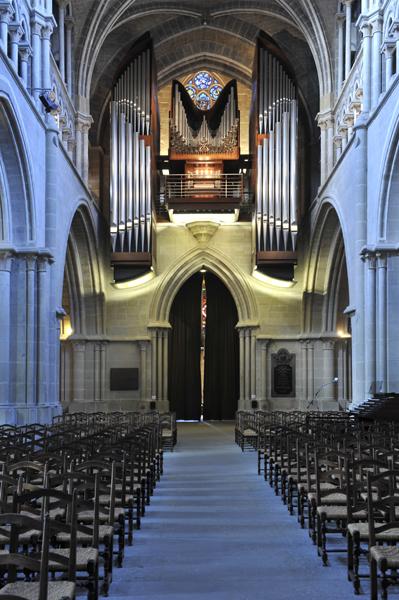Keeping watch over Lausanne nights

A bitterly cold January wind swirls around Lausanne's 13th-century Gothic cathedral, whipping recent snow off nearby rooftops.
The cathedral bell strikes ten. Suddenly a lone figure appears on the snow-covered belfry and calls out into the night: “C’est le guet! Il a sonné dix…Il a sonné dix!” (It’s the night watch. It’s ten o’clock. It’s ten o’clock).
Holding on tightly to his black wide-brimmed felt hat, Renato Häusler picks up his lantern and quickly rushes back into his tiny lodge, squeezed between the cathedral’s main bells.
“It’s not very nice outside – in here it’s much more comfortable,” he says, ushering us into his cosy room.
Häusler has just started his evening shift as Lausanne Cathedral’s night watchman.
Between 10pm and 2am, his powerful voice can be heard echoing across the city to mark the hours.
“Someone has been doing this job every night for the past 600 years,” he says, rubbing his cold hands together.
“It’s a real pleasure to be part of a tradition that has existed since the Middle Ages. And it’s a privilege to be alone in this wonderful building. It’s important to keep a human presence in a place like a cathedral,” he adds.
Fire alarm
According to official records, a night watch was established in Lausanne in 1405 following a large fire in a nearby district – but it is thought that watchmen were active there earlier.
“Fire was the main concern in the Middle Ages,” says 48-year-old Häusler.
Between the building of the cathedral in 1275 and the 17th century, six major fires destroyed large parts of the city, killing hundreds of people.
The night watch’s original job description was therefore to keep a look out for telltale signs of smoke, to sound the alarm, if needed, and to announce the time on the hour.
In 1880 the decision was taken to end fire surveillance, but someone was still needed to wind up the ancient 15th-century cathedral clock. Since then, with the odd hiccup, the town’s authorities have been firm supporters of the ceremonial post.
“It’s maintaining a tradition and symbol for Lausanne. It would be unthinkable to do away with the post,” Häusler reckons.
Today, he is one of only seven ceremonial night watchmen in Europe, but the only one who announces the time all-year-round from his bell tower.
He has been happily calling out the time for the last five years, but much longer if you include his 15 years as a replacement, and he hopes to continue at least until he retires.
“When I’m up here I’m able to distance myself from the day-to-day life. This place is a source of strength – this belfry which hasn’t moved for centuries.”
Active
But it’s not all about timekeeping. When he’s not at the cathedral, Häusler works as a swimming teacher for the blind and partially sighted.
And perched in his cosy lodge 30-metres above the cathedral entrance, in between his hourly rounds, he doesn’t have much time to rest.
Together with a doctor friend, he created an association, Actions Recherche Sida, which helps young African children affected by HIV/Aids. Thanks to the funds they’ve raised, 500 Rwandan Aids orphans are able to go to school.
“I’m able to do the whole administrative side of things up here,” he explains.
As he prepares to light the candle for his 11-o’clock round, he lets out a yawn: “It’s quite demanding. I only sleep about four or five hours a night, but I’m rarely tired. I’ve got used to living like that.”
And so has his family, apparently: “I see them in the morning, at lunchtime and in the evening. It’s become more normal for them – even though they realise that it’s quite an unusual job.”
Some nights, like tonight, when it’s too cold to cycle home, Häusler sleeps in his heated lodge. Just don’t expect any creature comforts.
It’s not that easy with his knees bent to squeeze into the 1.5-metre-long bed and his head only a few centimetres from the 5.6-ton Marie-Madeleine bell.
swissinfo, Simon Bradley in Lausanne
In the Middle Ages, Lausanne was a small town of 8,000 people packed into wooden houses in narrow streets. Fires were extremely common and watchmen were therefore needed, both at street level and at the cathedral, to ring fire bells and mark the time.
Following a major fire on October 25, 1405, the archbishop issued a series of fire-prevention decrees including the call for a cathedral night watch.
In total, there are seven cities in Europe who have continued to employ watchmen since the Middle Ages: Lausanne, three in Germany, Ripon in England, one in Sweden and Krakow in Poland. More recently, around 108 other towns and cities in Europe have started employing watchmen, mostly for tourist reasons.
Up until 1960 they marked the time from 9pm until 6am.Today, Renato Häusler calls the hours from 10pm until 2am.
Renato Häusler is 48 years old, and married with two daughters.
He has been the Lausanne Cathedral night watchman since 2002, but started as a replacement in 1987.
Häusler works part-time five days a week from 10pm to 2am. The rest of the time he works as a sports teacher for the blind and partially sighted.
He speaks French, Swiss-German, English, Italian and Spanish.
In 1999, together with a Swiss doctor, he set up the non-governmental organisation Actions Recherche Sida, which carries out medical research for children into HIV/Aids and helps orphans affected by the pandemic.

In compliance with the JTI standards
More: SWI swissinfo.ch certified by the Journalism Trust Initiative











You can find an overview of ongoing debates with our journalists here . Please join us!
If you want to start a conversation about a topic raised in this article or want to report factual errors, email us at english@swissinfo.ch.